Darling Hair, a hair manufacturer and distributor in Kenya, ran their loyalty program on paper vouchers, and customer conversations remained scattered across different threads. Flowcart turned those same conversations into a structured sales journey.
As a result, sales went up 300%, and their active customer base grew sevenfold.
Brands everywhere are realizing that WhatsApp isn’t just for support or promotions. It’s where customers discover, decide, and buy, all in one thread. This guide breaks down how to build a step-by-step WhatsApp sales funnel, with strategies, tools, and examples.
What is a WhatsApp Sales Funnel?
A WhatsApp sales funnel is a structured process that guides potential customers from first contact to purchase, using automated, personalized WhatsApp conversations instead of web pages or emails.
Let’s understand this with a comparison.
In a traditional funnel, every customer journey stage happens across different touchpoints: a landing page for awareness, an email sequence for nurturing, and a checkout page for conversion.
WhatsApp, on the other hand, brings everything in one place. A buyer can discover your product, ask a question, receive a catalog or offer, and complete their purchase within a single chat thread.
What makes this shift even more convincing is WhatsApp's conversion rates. 95% of WhatsApp messages are read within three minutes, and 45% of buyers prefer to complete purchases in chats. These numbers speak volumes about WhatsApp's credibility as a sales funnel.
In the next section, let’s look at the key benefits of building a structured WhatsApp sales funnel and why more brands are shifting their customer journeys to chat.
Must Read: WhatsApp Marketing Cost: Pricing, Factors, and How to Save Money
Benefits of Building a WhatsApp Sales Funnel
The average eCommerce conversion rate sits around 2.9% and most of that traffic drops off between “add to cart” and checkout.
That gap doesn’t exist on WhatsApp. When the entire buying journey happens inside a chat, there’s no page to abandon or form to ignore, just a real conversation that keeps moving forward.
Here’s what makes a WhatsApp sales funnel more effective than traditional ones:
- Shorten the path to purchase: Replace slow email exchanges and website drop-offs with real-time replies, in-chat payment, and quick actions.
- Deliver 1:1 personalization at scale: Automate conversations while tailoring messages to each customer’s interests, behavior, or purchase history.
- Reduce drop-offs with smart automation: Trigger reminders, follow-ups, and offers automatically to keep buyers moving toward checkout.
- Build lasting retention loops: Keep up post-purchase conversations through support, loyalty programs, and re-engagement campaigns.
Together, these benefits turn WhatsApp from a support channel into a full-fledged sales engine, one that guides customers from awareness to repeat purchase. Let’s break that journey down stage by stage.
Stages of the WhatsApp Sales Funnel
To build an effective WhatsApp funnel, you need to understand what happens at each stage of the buyer’s journey. Here’s a look at how awareness, engagement, consideration, conversion, and retention all play distinct roles in this process.
Stage 1: Awareness: Multi-Channel Lead Capture
The awareness stage is about getting prospects to start a conversation with intent.
Instead of pushing them through websites or sign-up forms, you meet them where they already spend time: social media, stores, and product pages. The goal is simple: make it effortless for someone interested in your product to open WhatsApp and connect.
Here’s how leading brands create a WhatsApp marketing strategy:
- Run click-to-WhatsApp ads: Launch Meta ads on Facebook and Instagram with “Message Us” CTAs that open pre-filled WhatsApp chats instantly.
- Place smart QR codes: Add scannable QR codes on packaging, store shelves, or event booths that lead customers directly to a pre-set WhatsApp conversation.
- Embed website chat widgets: Add “Chat on WhatsApp” buttons on pricing, product, or checkout pages to catch buyers at high-intent moments.
- Deliver lead magnets via WhatsApp: Share discounts, eBooks, or consultations directly through chat to spark immediate engagement.
- Link across channels: Add WhatsApp links to Instagram bios, YouTube descriptions, email signatures, and newsletters to turn passive interest into active chats.
Stage 2: Engagement: Intelligent Welcome Flows
The Engagement stage turns a new chat into a relationship. After a customer messages you for the first time, the goal is to respond fast, stay relevant, and guide the conversation.
This is where automation meets empathy, using smart, personalized flows that feel natural while collecting the data you need to qualify leads.
To build effective engagement on WhatsApp:
- Launch AI-powered welcome sequences: Greet new users instantly with personalized messages tailored to their entry point.
- Design interactive WhatsApp flows: Guide users through booking, browsing, or preference-sharing.
- Deploy intelligent chatbots: Automate responses for FAQs and basic queries, then route complex requests to live agents without losing context.
- Segment users through conversation: Tag and organize leads dynamically based on how they respond, what they browse, or what they ask about.
- Enrich chats with visual media: Use product carousels, short videos, and GIFs to keep conversations engaging and make your brand feel human.
Stage 3: Consideration: Social Proof and Product Discovery
At this stage, potential buyers already know who you are; now they’re deciding why they should choose you. You need to build their confidence with clear answers, credible evidence, and easy access to what they need.
WhatsApp makes this simple by turning questions into conversations and product discovery into dialogue.
Here’s how to build trust and guide decisions:
- Show products inside chat: Use WhatsApp Catalogs to display curated collections and personalized product recommendations without redirecting users.
- Share social proof instantly: Send testimonials, reviews, and customer stories in chat to reinforce credibility when intent is highest.
- Offer personalized demos: Use short videos, voice notes, or one-on-one consultations to explain features and demonstrate value clearly.
- Connect users to agents fast: Route high-intent buyers to sales reps for custom quotes or detailed product guidance without delay.
- Educate with comparisons: Share quick “product vs. alternative” breakdowns or how-to guides that simplify decision-making.
Stage 4: Conversion: Frictionless Purchase
The Conversion stage turns interest into revenue. Make checkout effortless here because every extra click or delay increases the chance of losing a buyer.
WhatsApp simplifies this by letting customers confirm, pay, and receive updates without leaving the chat.
To optimize conversions:
- Recover dropped carts automatically: Send personalized reminders, exclusive discounts, or restock alerts to re-engage customers within 24 hours.
- Enable seamless payments: Integrate WhatsApp-native payments or secure one-click checkout links to let buyers complete transactions instantly.
- Provide live support during checkout: Keep agents available to resolve last-minute doubts or assist with custom and bulk orders in real time.
- Create urgency strategically: Use countdown timers, limited-time offers, or low-stock alerts to encourage faster decisions.
- Confirm purchases instantly: Deliver receipts, delivery updates, and clear next steps immediately after checkout to reinforce trust and reduce buyer hesitation.
Stage 5: Retention: Loyalty Programs and Community Building
Retention is about keeping customers engaged, supported, and valued long after their first purchase. WhatsApp makes this simple by keeping communication open, personal, and immediate.
To strengthen retention through WhatsApp:
- Run loyalty programs inside chat: Allow customers to check points, redeem rewards, and unlock exclusive perks directly through WhatsApp.
- Automate post-purchase journeys: Share order updates, product usage tips, and review requests to maintain engagement after delivery.
- Re-engage customers personally: Send restock alerts, milestone offers, or birthday messages to naturally spark repeat purchases.
- Build customer communities: Create VIP groups or broadcast lists for early product access, feedback, and ongoing brand interaction.
- Close the feedback loop: Collect reviews, conduct quick polls, and use insights to improve product quality and customer experience.
Each of these stages works best when your systems talk to each other. If you’d rather skip the setup and see it in action, book a Flowcart demo to watch how automated WhatsApp funnels run end to end.
Tools to Create WhatsApp Sales Funnels
Behind every smooth WhatsApp journey is a tool that keeps messages flowing, data organized, and sales moving. Here’s how leading platforms stack up in helping teams do exactly that.
Each of these tools plays a distinct role in building a high-performing WhatsApp funnel. Once you’ve chosen the right platform for your business, the next step is putting it all together, designing a funnel that guides customers from first message to purchase.
Recommended Read: Best WhatsApp Marketing Tools to Grow Your Business
Building a WhatsApp funnel doesn’t need big budgets or complex setups. Flowcart’s pricing is designed for teams that want to start fast, test, and grow as results come in. Explore the plans to find one that fits your business stage.
How to Build a WhatsApp Sales Funnel (Step by Step)
Follow these steps to create a funnel that captures leads, nurtures conversations, and drives consistent sales through chat.
Step 1: Capture Leads
Lead capture on WhatsApp creates instant entry points that let customers start a conversation the moment interest sparks. Instead of redirecting traffic to landing pages, brands use click-to-chat links, QR codes, and website widgets to bring potential buyers directly into WhatsApp. This removes the traditional friction between discovery and engagement, turning curious visitors into active leads in seconds.
Flowcart takes care of this for you in two ways:
Its Click-to-whatsApp ads turn every Meta campaign into a direct entry point, connecting high-intent buyers to your brand in seconds. Flowcart also tracks each campaign end-to-end. It links directly to your Meta Ad Account, identifies which ads convert best, and automatically sends performance data back to Meta to improve targeting and ROAS.
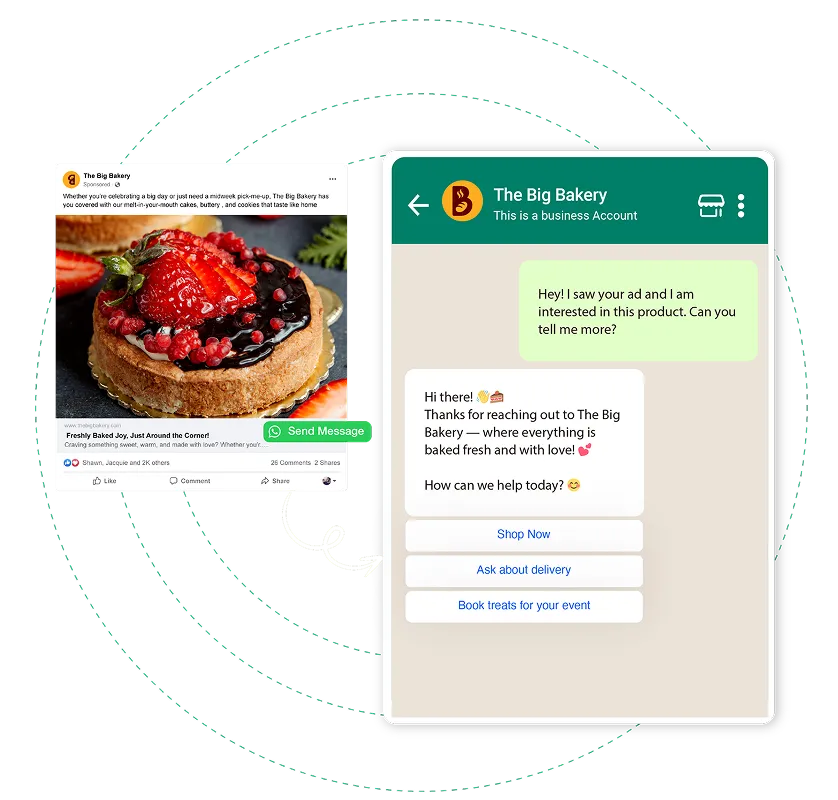
Secondly, it also positions QR codes for offline campaigns. A quick scan on a product box or store display opens a pre-filled WhatsApp chat, turning walk-ins into leads and one-time buyers into repeat customers.
Step 2: Set Up Welcome Automation
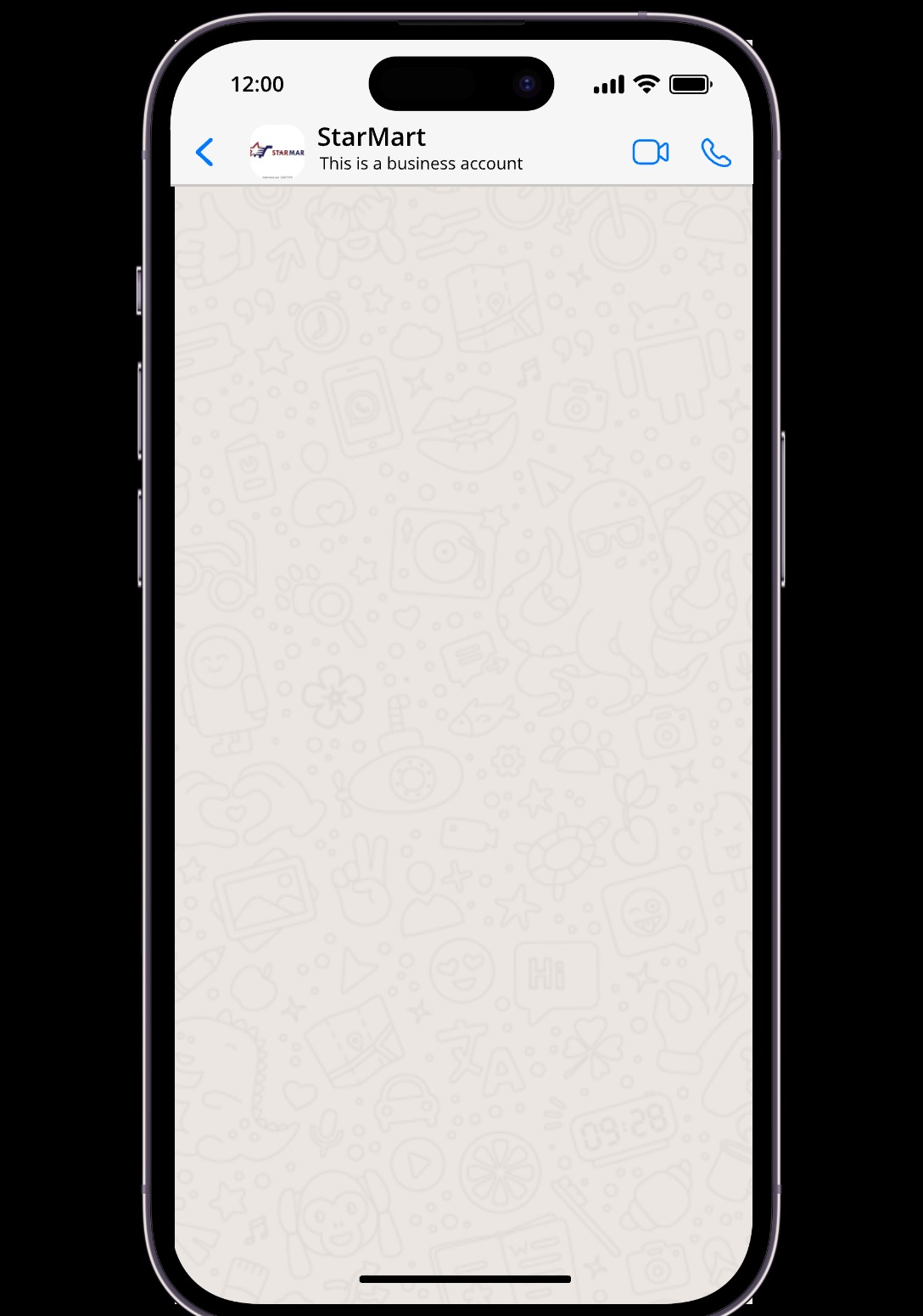
The moment a customer opens the chat is your chance to make the first message count. A quick, structured welcome flow helps them find what they came for, whether it’s browsing products, checking offers, or speaking to a live agent.
Flowcart makes this process instant through its AI-driven WhatsApp flows. Each visitor receives a personalized welcome menu tailored to their campaign source or shopping history. Within seconds, they can choose whether to browse a catalog, view their cart, book a consultation, or talk to support. The best part is that all these actions are guided by automated responses that feel natural.
Behind the scenes, Flowcart’s AI automatically handles qualification and routing. It recognizes high-intent moments, loops in a live agent when needed, and keeps the rest of the chat flowing on autopilot. Most customers reach a product in under three taps, and brands using Flowcart’s welcome flows report up to 28 % higher conversions on first sessions.
Also Read: WhatsApp Marketing Automation: The Complete Guide
Step 3: Segment Customers
Once your funnel starts attracting conversations, not every buyer should see the same message. A returning customer who’s bought twice doesn’t need a “Welcome” offer, and a dormant lead shouldn’t get the same broadcast as an active one. Segmentation keeps your communication relevant, and Flowcart automates it.
AI-Powered Segmentation in Flowcart groups customers based on their real-time behavior, like product views, clicks, cart value, purchase frequency, or last interaction date. These insights power Smart broadcasts that reach the right people, at the right time, with the right offer. For example, a high-spender might receive an exclusive bundle discount, while inactive users get a restock reminder or a limited-time deal.

Each segment becomes a self-sustaining mini-funnel. Flowcart tracks opens, clicks, and conversions in real time, sending performance data back into the system to refine targeting. Brands using Flowcart’s segmentation and broadcast automation report up to 5× higher revenue and 3× more engagement compared to untargeted campaigns.
Step 4: Push Offers and Catalogs
Once customers are engaged, the next step is to make buying effortless. Instead of sending them to a website or hoping they’ll complete checkout later, guide them to the exact product and let them finish the purchase right inside WhatsApp.
The AI-Generated Carts in Flowcart analyze each customer’s chat behavior, preferences, and purchase history to recommend the right products and bundles in real time.
When a buyer asks for “a lightweight running shoe under ₹3000,” Flowcart responds instantly, checking live inventory, suggesting the best fit, and dropping a one-tap cart directly in the chat. Smart upsells and bundled suggestions lift average order value by up to 18%, while cart drop-offs fall by 30%.
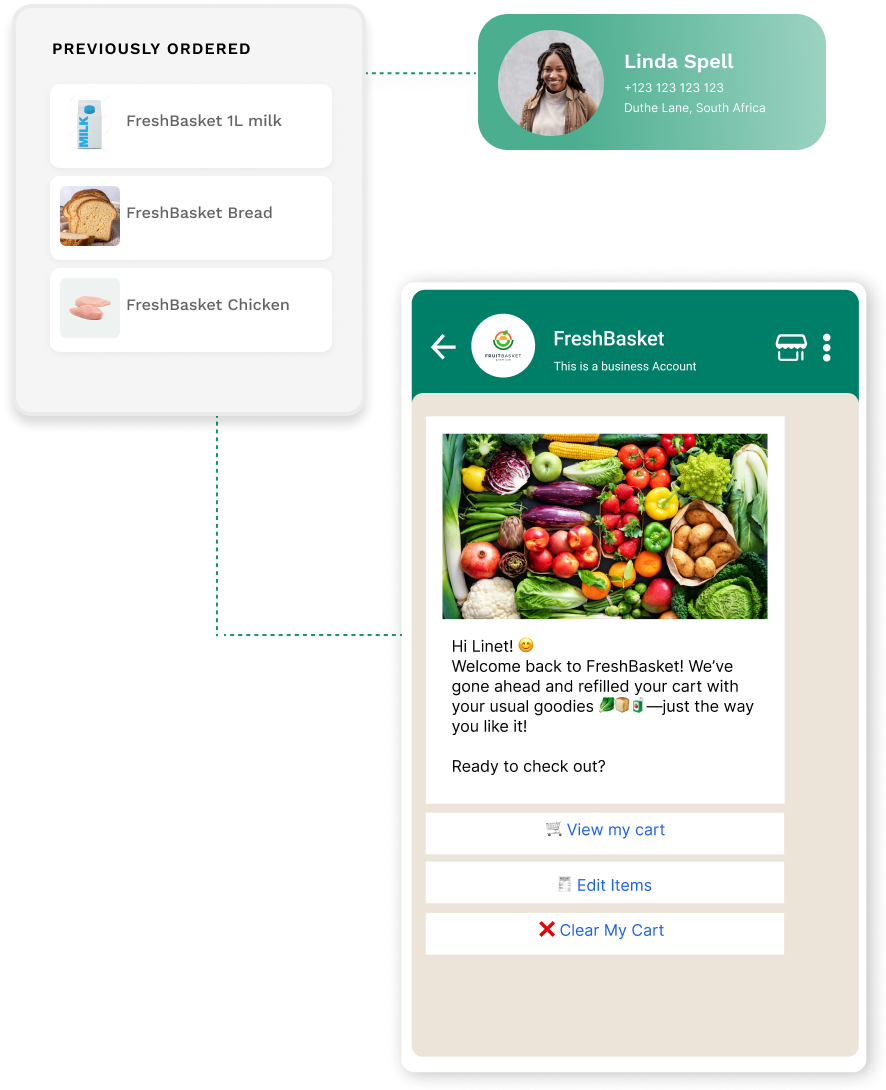
Once the buyer’s ready, In-Chat Checkout completes the loop. Flowcart auto-fills customer details, supports multiple payment methods, and sends real-time order confirmations within the same conversation.
For your team, this means fewer missed opportunities and higher conversion rates without added effort. For your customers, it’s the simplest buying experience they would ever have: browse, decide, and pay in a single chat.
Step 5: Recover Abandoned Carts
Even the most engaged buyer sometimes stops just short of checkout. They get distracted, switch apps, or decide to “come back later.” For most brands, that moment is a lost sale. For Flowcart users, it’s just another step in the funnel.
It detects when a shopper drops off mid-purchase and triggers a personalized WhatsApp follow-up at the perfect time with an exclusive offer. Each Abandoned Cart Recovery message includes a visual cart preview, a one-tap checkout link, and an optional incentive so customers can finish the purchase in seconds.
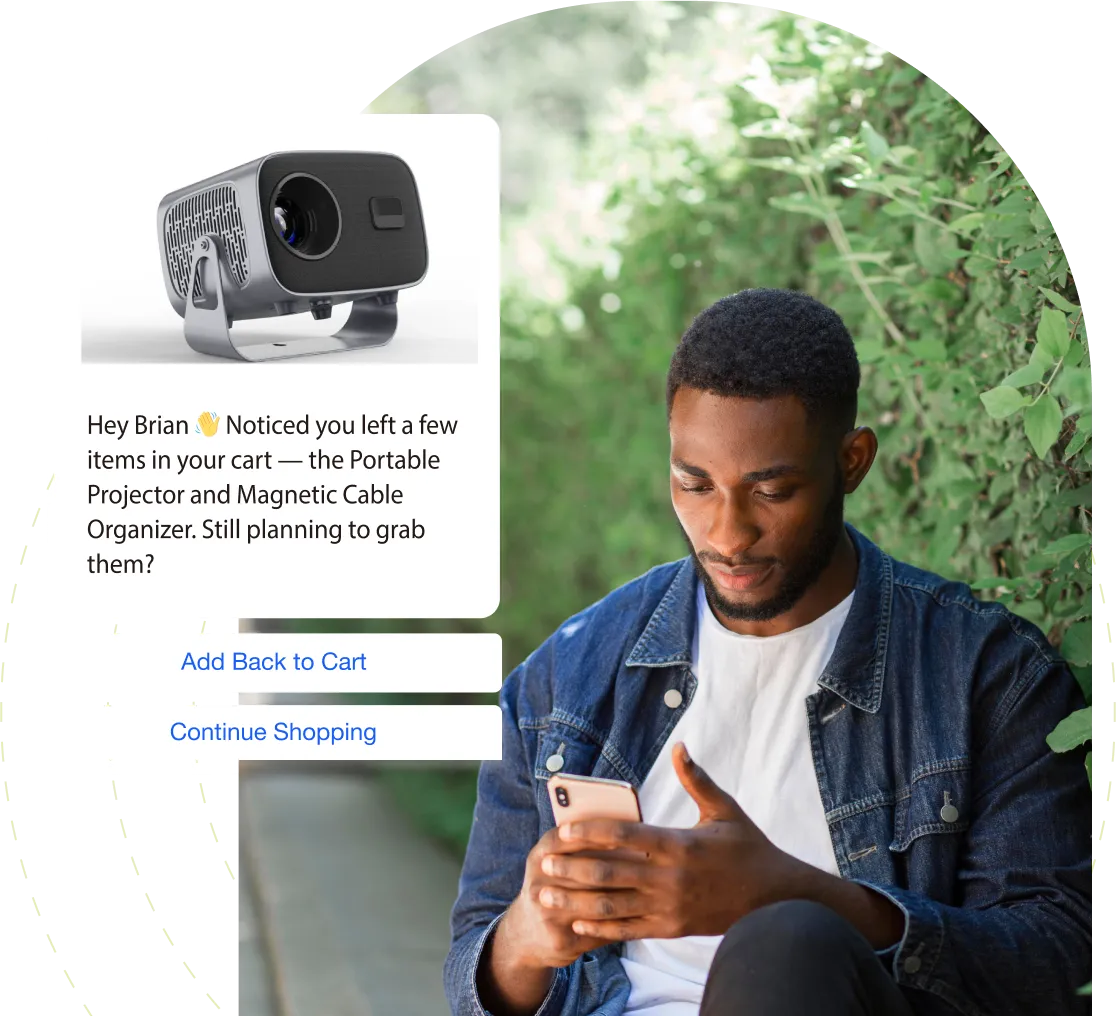
Flowcart users report conversion rates up to 45% on recovery messages, 60% click rates, and 98% open rates because reminders land exactly where the conversation started. Every message feels like a helpful nudge.
The results are measurable: up to 800% more recovered sales, fewer wasted ad spends, and a cleaner buyer experience.
Step 6: Retain with Loyalty Programs
Does the conversation between your brand and the customer conclude once the sale is done? No! In fact, it’s a perfect reason to start the next one. Loyalty programs keep customers engaged long after checkout.
Flowcart’s automated Loyalty Program lets customers earn points for every action, from purchases and referrals to feedback and reviews, and tracks everything directly in their WhatsApp wallet. They can view balances, redeem rewards for future purchases, or even cash out points through mobile money, all without leaving the chat.
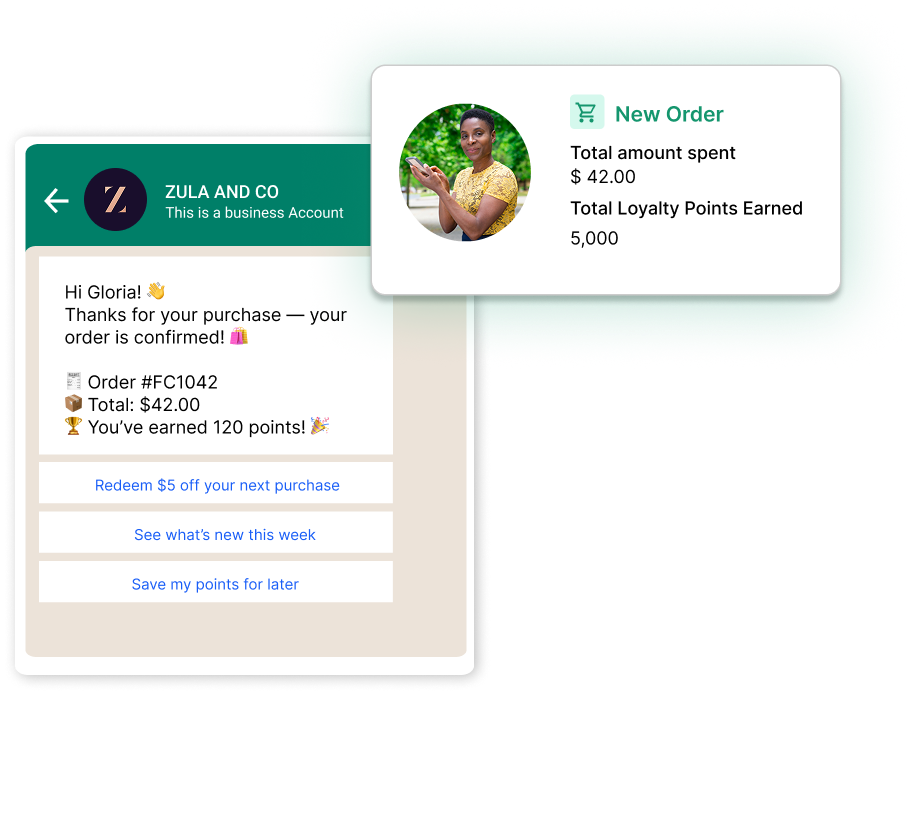
Behind the scenes, Flowcart automates point assignment, redemption rules, and reactivation campaigns for dormant users. Brands use it to nudge repeat purchases (“Use your points on this new drop”) or reward milestones (“You’ve hit 1,000 points. Here’s 10% off your next order”).
As a result, you can expect higher retention, repeat orders, and a clear increase in customer lifetime value.
How Kings Wear 4X’d Online Sales with Flowcart
Kings Collection, a growing fashion brand in Kenya, was struggling to manage orders across multiple disconnected channels. Customers were placing orders via calls, DMs, and websites, creating delays, confusion, and fulfillment errors. Post-purchase follow-ups were inconsistent, and every delivery required manual coordination between sales reps and dispatch teams.
By integrating with Flowcart, Kings Collection rebuilt its sales funnel directly in WhatsApp, unifying ordering, communication, and delivery tracking into a single seamless system.
Here’s how they did it:
- End-to-End Order Management: Retail and wholesale customers now place, confirm, and track their orders entirely within WhatsApp.
- AI-Powered Conversations: Flowcart’s AI responds instantly to product inquiries, confirms availability, and even generates ready-to-checkout carts.
- In-Chat Fulfillment: Real-time order updates and delivery confirmations have replaced manual follow-ups and phone coordination.
The results:
Kings Collection grew online sales by 400%, with 70% of all orders now handled through WhatsApp. The team reports fewer dispatch errors, faster order confirmations, and stronger buyer trust across both retail and wholesale channels.
Stories like this happen when brands start treating WhatsApp as more than a chat app. Each business finds its own rhythm, its own version of “this works.” If you’d like to see how others built theirs, explore more Flowcart case studies.
Future Trends in WhatsApp Funnels
Every few years, a new tool changes how we talk to customers. WhatsApp did that once already, and it’s about to do it again. The next phase of sales funnels will be powered by AI, voice, and native checkout, turning WhatsApp into a complete commerce ecosystem.
1. AI-Powered Funnel Optimization
Artificial intelligence has quietly become the engine behind the most efficient WhatsApp funnels. What used to rely on intuition and timing is now guided by data: predictive models that read intent, automate follow-ups, and adapt messages faster than any human team could.
Gartner reports that over half of organizations use conversational AI in customer-facing roles. These systems no longer stop at answering questions. They check stock, process payments, and hand off to agents when a human touch matters most.
Within the first few messages, algorithms can now predict which leads are likely to convert and which need nurturing. The technology enables teams to prioritize high-intent buyers automatically.
But prediction is only half the story. AI can also personalize your outreach. Machine learning models tailor every WhatsApp interaction to a person’s browsing habits, tone, and timing. On the backend, intelligent automation continues to learn in real time. AI chat systems use A/B test message variations, refine conversation paths, and optimize flows without manual updates.
They send the right offer at the right moment, adjust recommendations based on behavior, and even sense hesitation through sentiment analysis.
2. WhatsApp-Native Checkout
Customers are tired of broken handoffs and slow-loading pages. They want to browse, confirm, and pay in one place. Messaging platforms, especially WhatsApp, are meeting that expectation faster than traditional e-commerce channels can adapt.
Forrester calls it the age of Agentic Commerce, where purchases happen inside the same interface that sparked the discovery. OpenAI’s Instant Checkout and Meta’s native payment infrastructure have set the tone: users can now complete a transaction, from browsing to payment, within a single conversation thread.
What began as a convenience feature has turned into a structural change in how people buy. There are no redirects, no cart abandonment, and no context switch. Just a straight line from “I want this” to “I bought it.”
Put simply, the future of digital commerce will belong to brands that close the gap between discovery and decision. WhatsApp-native checkout is that bridge, a unified experience where shopping, talking, and paying are no longer separate steps, but one seamless flow.
Additional Read: WhatsApp Conversational Marketing: Strategies, Examples, and Best Practices
3. Voice and Video-Driven Funnels
Voice and video are changing how customers interact with brands, closing the gap between digital convenience and human connection. Buyers can ask, see, and decide in real time, all within the same chat.
This behavior extends naturally to WhatsApp, where voice messages are second nature. Soon, customers won’t just text “What’s in stock?”, they’ll say it, triggering voice-activated product searches, orders, or service requests.
Video adds another layer of engagement. Gartner’s Market Guide for Live Commerce highlights that retailers investing in live and shoppable video experiences are already seeing higher conversion rates. Video demos, quick consultations, and product explainers fulfill what customers crave: interactivity and trust.
The future will blend these modes seamlessly. Text, voice, video, and visuals will coexist in the same WhatsApp thread, adapting to each customer's preferred engagement. Thus, turning the platform into a sensory interface for discovery and purchase.
Build Your Own Sales Funnel with Flowcart
Every sale starts with a conversation, and WhatsApp is where those conversations now live. It’s the space where customers discover, compare, and buy without ever leaving the chat. For brands that know how to use it, that simplicity becomes their biggest advantage.
Flowcart helps you turn that advantage into structure. It brings every stage of your WhatsApp funnel into one connected system that runs smoothly, even when your team is offline. You can expect faster replies, shorter sales cycles, and stronger customer relationships that last beyond a single purchase.
If you’re ready to move from scattered chats to a funnel that sells for you, start your free trial and see how Flowcart builds that flow.
FAQs
How do I start a WhatsApp sales funnel for small businesses?
Start by mapping your customer journey, from how people discover your business to how they buy and return. Use simple entry points like Click-to-WhatsApp ads, QR codes, or website chat buttons to capture leads, then automate responses for FAQs and follow-ups. As you grow, WhatsApp marketing tools can help structure and scale these steps into a complete funnel.
What’s the average ROI of a WhatsApp sales funnel?
ROI varies by industry, but businesses using WhatsApp for structured funnels often see higher engagement and faster conversions than with email or web forms. Many brands report a clear revenue and customer retention uplift after shifting their marketing and sales journeys to personalized, chat-based experiences.
Can I integrate WhatsApp funnels with Shopify/WooCommerce?
Yes. Both Shopify and WooCommerce support WhatsApp integrations that enable automated order confirmations, cart recovery, and customer support via chat. Platforms like Flowcart connect seamlessly with these systems, syncing your catalog, payments, and customer data without extra setup.
How do I measure funnel performance?
Track metrics like response time, conversion rate per funnel stage, cart recovery rate, and customer retention. WhatsApp analytics and CRM dashboards can help you see how each message contributes to revenue. If you’re using Flowcart, these insights are visualized automatically, from first chat to final purchase.

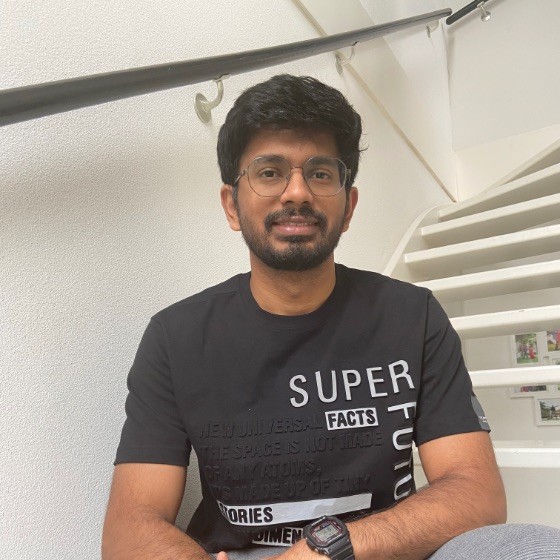
.png)
.png)


%201.webp)


